Zone
Crash of a Convair CV-580 in La Grande-4
Date & Time:
Sep 27, 2000 at 1038 LT
Registration:
C-GFHH
Survivors:
Yes
Schedule:
Montreal – Rouyn – La Grande-3 (LG-3) – La Grande-4 (LG-4) – Montreal
MSN:
109
YOM:
1953
Flight number:
APZ180
Crew on board:
3
Crew fatalities:
Pax on board:
18
Pax fatalities:
Other fatalities:
Total fatalities:
0
Captain / Total hours on type:
6000.00
Copilot / Total hours on type:
4000
Aircraft flight hours:
78438
Circumstances:
The Hydro-Québec Convair 340 (580), registration C-GFHH, serial number 109, with 18 passengers and 4 crew members on board, made an instrument flight rules flight from La Grande 3 to La Grande 4, Quebec. The aircraft touched down on the snow-covered runway at La Grande 4 approximately 800 feet beyond the runway threshold. Shortly after the nose wheel touched down and the pilot set the propellers to reverse pitch, the aircraft drifted to the right. Despite the attempts of the pilot flying (the captain) to correct, the aircraft continued its course and exited the south side of Runway 09 at approximately 50 knots. The aircraft travelled 350 feet over soft, rocky ground and came to rest about 120 feet outside the runway edge, about 2500 feet from the runway threshold. The flight crew followed the procedure to shut down the engines, but the left engine would not stop. On the captain's order, the first officer went into the passenger cabin and ordered an evacuation. All passengers exited the aircraft via the window emergency exits over the right wing. The left engine eventually shut down on its own after about 15 minutes. Five persons sustained minor injuries. The aircraft sustained substantial damage but did not catch fire.
Probable cause:
Findings as to Causes and Contributing Factors:
1. The steering control valve lever was not reassembled in accordance with the specifications and the drawings in the overhaul manual and the maintenance manual: the lever was assembled with two washers instead of one, and the circumference of the bushing was 0.0005 inch greater than the circumference of the hole in the lever. These two deficiencies created additional resistance that
impeded the pivoting of the aircraft steering wheel.
2. The nylon locknuts were reinstalled during the repair of the steering control valve, contrary to the recommendation that they be used only once. The locknuts then came loose in service, creating play in the parts of the valve.
3. Incorrect interpretation of the problem and the influence of previous experience using the nose-gear steering wheel led the crew to make the flight despite their concern about the aircraft's nose-gear steering system.
Findings as to Risk:
1. The maintenance personnel of Precision Aero Components Inc. used the (incomplete) maintenance manual instead of the overhaul manual to overhaul and repair the steering control valve,
contributing to the incorrect reassembly of the valve.
2. The steering control valve lever was not fitted with a grease fitting, and the outside of the bushing was not grooved to allow adequate lubrication, thereby risking corrosion and seizure of the bushing inside the lever.
3. The limited experience and the lack of formal training of the maintenance personnel concerning the repair and the overhaul on the steering control valve might have contributed to the incorrect
reassembly of the steering control valve.
4. The pilot flying cut the electrical power, as required by the hard landing procedure. The left engine could therefore not be shut down, causing a risk of injury when the passengers evacuated.
5. The pilot flying cut the electrical power after the aircraft exited the runway, as required by the hard landing procedure. The electrical power required to operate the public address and alarm systems was thereby lost, and the evacuation could not be ordered promptly.
6. The evacuation slide automatic deployment system was inadvertently deactivated, which could have delayed the evacuation and compromised passenger safety.
7. After separating from the engine, the left propeller blades entered the fuselage and damaged an unoccupied seat.
Other Findings:
1. The numerous changes in ownership of the Convair type certificate and the lack of technical support from the current holder caused maintenance problems for Convair operators and approved
maintenance organizations (AMOs), particularly for recently established AMOs.
1. The steering control valve lever was not reassembled in accordance with the specifications and the drawings in the overhaul manual and the maintenance manual: the lever was assembled with two washers instead of one, and the circumference of the bushing was 0.0005 inch greater than the circumference of the hole in the lever. These two deficiencies created additional resistance that
impeded the pivoting of the aircraft steering wheel.
2. The nylon locknuts were reinstalled during the repair of the steering control valve, contrary to the recommendation that they be used only once. The locknuts then came loose in service, creating play in the parts of the valve.
3. Incorrect interpretation of the problem and the influence of previous experience using the nose-gear steering wheel led the crew to make the flight despite their concern about the aircraft's nose-gear steering system.
Findings as to Risk:
1. The maintenance personnel of Precision Aero Components Inc. used the (incomplete) maintenance manual instead of the overhaul manual to overhaul and repair the steering control valve,
contributing to the incorrect reassembly of the valve.
2. The steering control valve lever was not fitted with a grease fitting, and the outside of the bushing was not grooved to allow adequate lubrication, thereby risking corrosion and seizure of the bushing inside the lever.
3. The limited experience and the lack of formal training of the maintenance personnel concerning the repair and the overhaul on the steering control valve might have contributed to the incorrect
reassembly of the steering control valve.
4. The pilot flying cut the electrical power, as required by the hard landing procedure. The left engine could therefore not be shut down, causing a risk of injury when the passengers evacuated.
5. The pilot flying cut the electrical power after the aircraft exited the runway, as required by the hard landing procedure. The electrical power required to operate the public address and alarm systems was thereby lost, and the evacuation could not be ordered promptly.
6. The evacuation slide automatic deployment system was inadvertently deactivated, which could have delayed the evacuation and compromised passenger safety.
7. After separating from the engine, the left propeller blades entered the fuselage and damaged an unoccupied seat.
Other Findings:
1. The numerous changes in ownership of the Convair type certificate and the lack of technical support from the current holder caused maintenance problems for Convair operators and approved
maintenance organizations (AMOs), particularly for recently established AMOs.

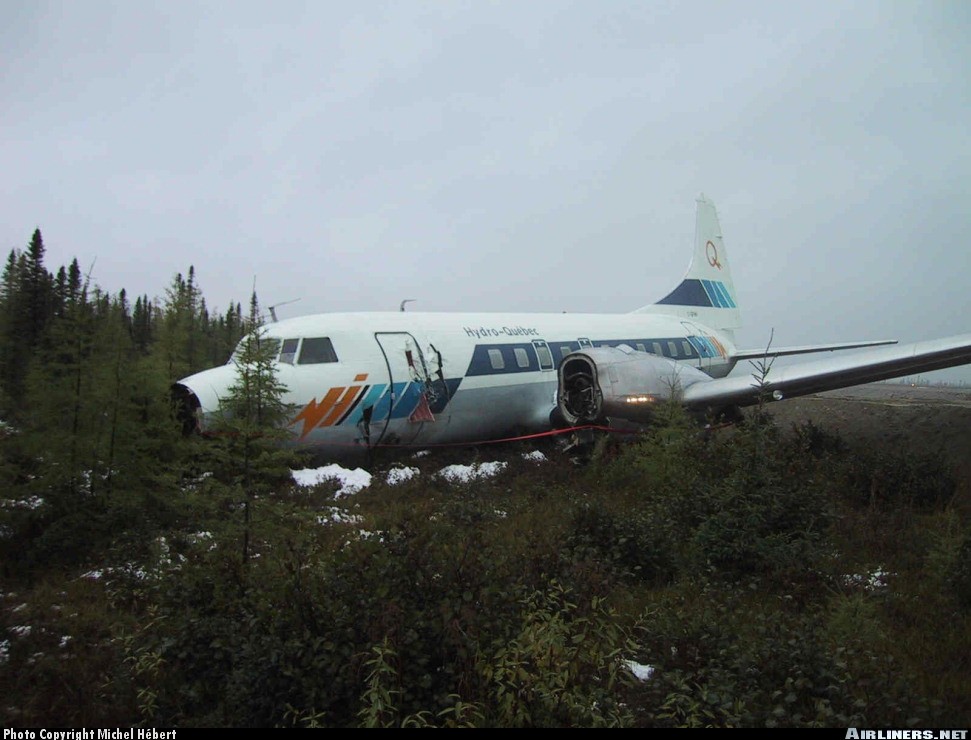
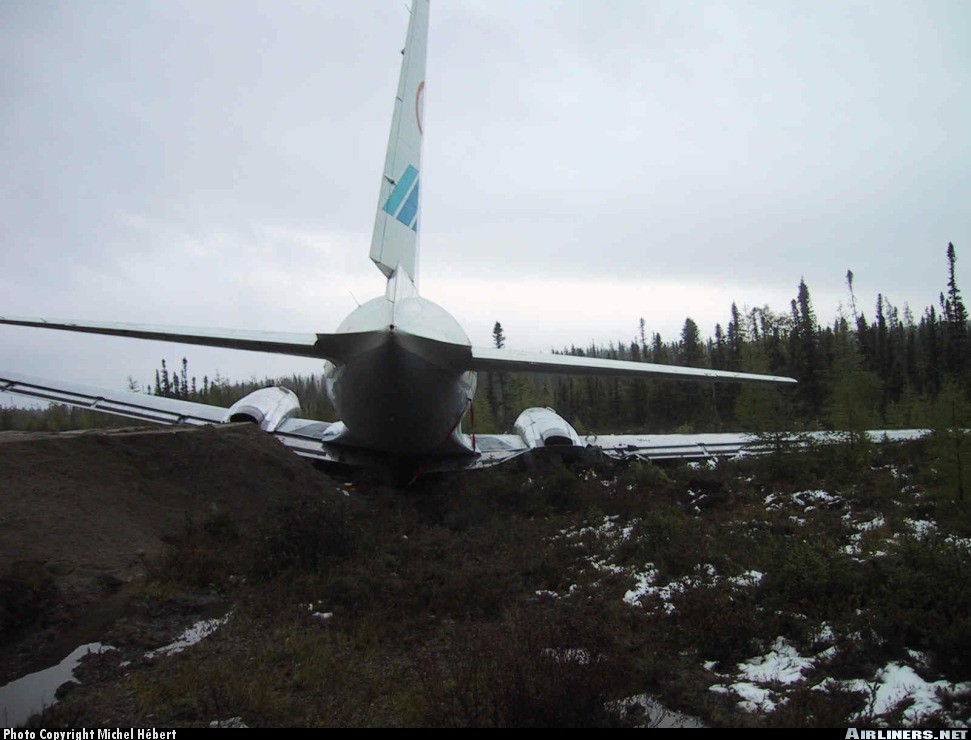
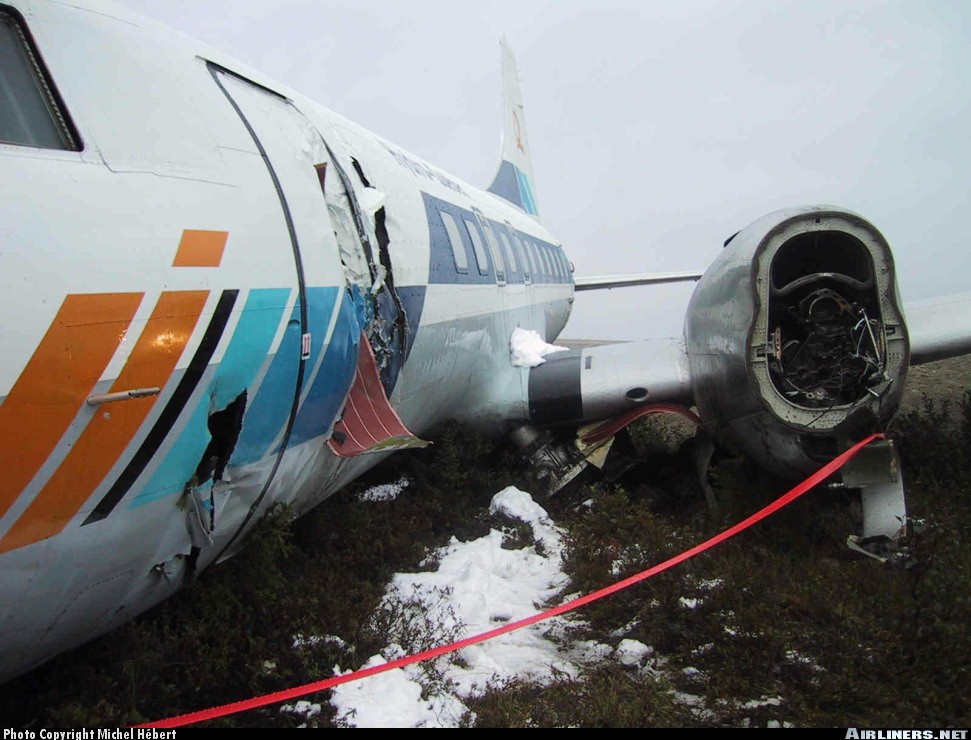
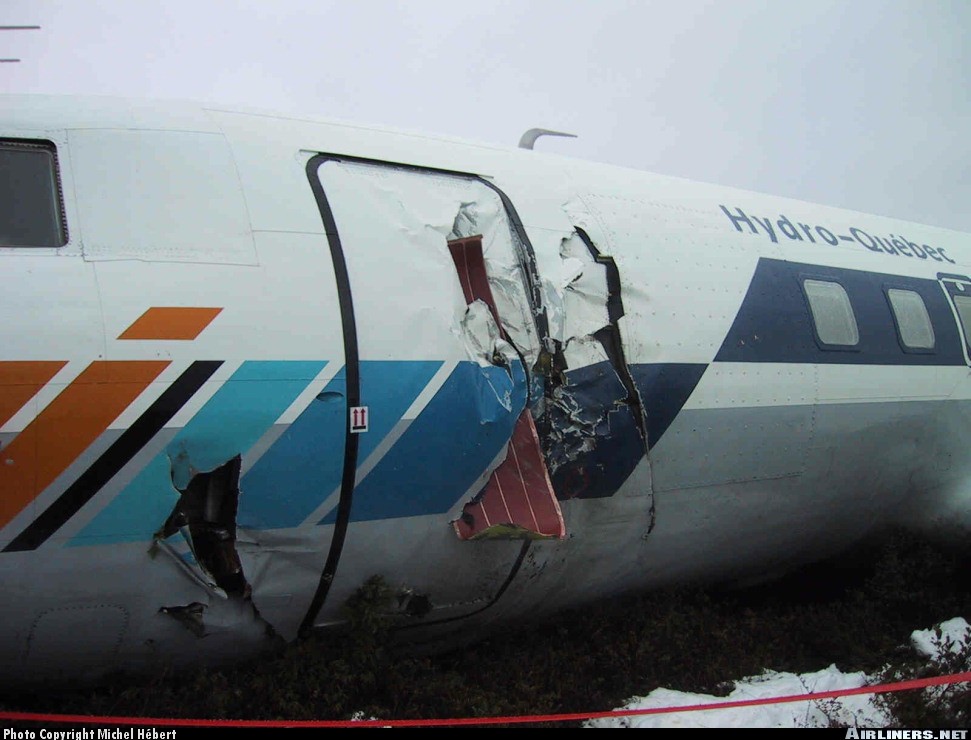
Crash of a BAe 125-400A in Churchill Falls: 8 killed
Date & Time:
Dec 9, 1977 at 1955 LT
Registration:
C-FCFL
Survivors:
No
Schedule:
Montreal - Churchill Falls
MSN:
25213
YOM:
1970
Crew on board:
2
Crew fatalities:
Pax on board:
6
Pax fatalities:
Other fatalities:
Total fatalities:
8
Captain / Total hours on type:
3100.00
Copilot / Total hours on type:
2600
Circumstances:
The corporate jet HS-125 aircraft departed Montreal at 2123 (GMT), 9 December 1977 with Churchill Falls as destination. The estimated time en route was 1 hour 45 minutes. The flight proceeded normally and was in contact with Air Traffic Services en route. When in range of Churchill Falls the flight received a clearance for the approach from Moncton ATC. At 2228Z the pilot acknowledged the clearance to the Churchill Falls airport and received the latest weather. The aircraft left cruising altitude shortly thereafter; the descent was normal to the minimum initial altitude for the instrument approach. The flight reported outbound to Churchill Falls advisory at approximately 2252Z. The final transmission from the crew was that they were two miles back on final with a confirmation that they could see the strobe lights and the VASIS. Moncton Centre was alerted shortly after 2300Z when it was evident that the aircraft had not landed. A local search was initiated with two helicopters from the airport but because of deteriorating weather, the search had to be discontinued and the aircraft was not found that night. Search and Rescue were alerted at 2314Z. Near blizzard conditions occurred that night and the next day, December 10. It wasn't until 11 December that the air search was resumed and the aircraft was located two miles short of the threshold of runway 14. There was no sign of life.
Probable cause:
It was determined that the accident was the consequence of the combination of the following findings:
- Cockpit discipline was inadequate as the approach entered the final phase,
- Distractions in the cockpit degraded crew performance,
- The pilots deprived themselves of essential altitude information by not effectively monitoring the flight instruments during the final approach,
- The Captain, by relying on visual cues from the runway environment lighting in conditions where those cues were degraded, became exposed to visual illusions,
- The pilots permitted the aircraft to deviate below the safe approach profile until it struck the terrain,
- On the assumptions that there had been at least one serviceable ELT on board, that it had been activated as a result of the impact or by other means, and that there was the capability at Churchill Falls of homing to the point of origin of the ELT signal, the rescue activity may have been expedited.
- Cockpit discipline was inadequate as the approach entered the final phase,
- Distractions in the cockpit degraded crew performance,
- The pilots deprived themselves of essential altitude information by not effectively monitoring the flight instruments during the final approach,
- The Captain, by relying on visual cues from the runway environment lighting in conditions where those cues were degraded, became exposed to visual illusions,
- The pilots permitted the aircraft to deviate below the safe approach profile until it struck the terrain,
- On the assumptions that there had been at least one serviceable ELT on board, that it had been activated as a result of the impact or by other means, and that there was the capability at Churchill Falls of homing to the point of origin of the ELT signal, the rescue activity may have been expedited.
Final Report:
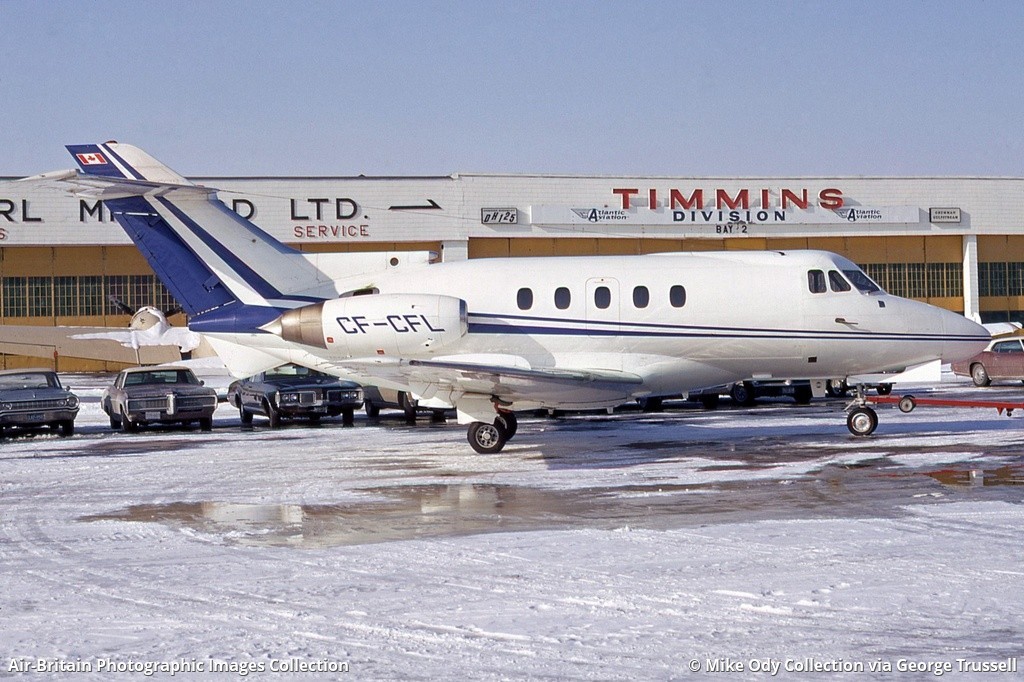
Crash of a Douglas DC-8-63 in Toronto: 109 killed
Date & Time:
Jul 5, 1970 at 0809 LT
Registration:
CF-TIW
Survivors:
No
Schedule:
Montreal - Toronto - Los Angeles
MSN:
46114/526
YOM:
1970
Flight number:
AC621
Crew on board:
9
Crew fatalities:
Pax on board:
100
Pax fatalities:
Other fatalities:
Total fatalities:
109
Captain / Total hours on type:
2899.00
Copilot / Total hours on type:
5626
Aircraft flight hours:
453
Circumstances:
Flight number 621 of Air Canada DC-8-63 CF-TIW with 100 passengers, six cabin air crew and three flight crew aboard on July 5, 1970 from departure at Montreal International Airport until its final crash at Toronto International Airport lasted slightly more than 52 minutes. This aircraft took off at Montreal at 07 hours and 17 minutes EDT, initially touched down on runway 32 at Toronto International Airport at 08 hours 06 minutes and 36 seconds EDT and finally crashed at 08 hours 09 minutes 34 seconds EDT. The flight from Montreal to Toronto was routine. The flight during this interval was also routine. The "In-Range Check" was made when the aircraft was about 10 miles from Toronto International Airport on a southerly heading. The "Before-Landing Check" was made when the aircraft was about 8 miles from this Airport, and just commencing its turn onto final approach. On this Before-Landing cockpit check, which includes the lowering of the undercarriage, the item "spoilers armed" was intentionally omitted. During this period there occurred a conversation between the Captain and the First Officer as to whether the ground spoilers would be armed 'on the flare' or 'on the ground' and an agreement between them as to this was reached. The agreement was that the First Officer would arm them 'on the flare', that is, immediately before the aircraft touched down on the runway. Power was reduced then on the aircraft for the purpose of the flare and the Captain gave the order to the First Officer by saying 'OK'; and immediately thereafter the ground spoilers were deployed. The spoilers were deployed when the aircraft was about 60 feet above the runway. As a result, the aircraft sank rapidly. Practically immediately thereafter the Captain, with an exclamation, applied full throttle to all four engines and pulled back the control panel causing the nose of the aircraft to rotate upwards. During this sequence the First Officer apologized to the Captain for what he had done. Notwithstanding the action taken by the Captain, he did not succeed in preventing the aircraft from touching down on the runway. Instead, the aircraft struck the runway very heavily. It remained on the runway only about half a second and then rose back into the air at which time the ground spoilers commenced to retract and then did retract. When the aircraft struck the runway, number 4 engine and pylon separated from the aircraft and fell on the runway along with a piece of the lower wing plating (which allowed fuel to escape and subsequently ignite). Damage was also done at this time to the attachments relating to number 3 engine, but that engine after touchdown continued to function. After this touchdown, the aircraft climbed to an altitude of 3,100 feet above the ground. During this climb, there were conversations between the First Officer and the aircraft airport control tower from which it is patent, that the air crew considered that they would be able to cause their aircraft to circle for another landing attempt on runway 32. In fact, the air crew did not know, until only about 40 seconds prior to the final crash, that the happening of such final crash was irreversible. During this climb, fire and smoke were seen trailing behind the aircraft intermittently. About 2 and one half minutes after the initial touch down of this aircraft on the runway, the first explosion occurred in the right wing outboard of number 4 engine location causing parts of the outer wing structure to fall free to the ground. Six seconds later, a second explosion occurred in the vicinity of number 3 engine and the engine with its pylon ripped free of the wing and fell to the ground in flames, trailing heavy black smoke. Six and one half seconds later, a third explosion occurred which caused the loss of a large section of the right wing, including the wing tip. The aircraft then went into a violent manoeuvre, and with the right wing still ablaze, lost height rapidly and at the same time more wing plating tore free following which the aircraft struck the ground at a high velocity, about 220 knots in the attitude with the left wing high and the nose low. At final crash, all persons aboard this aircraft were killed.
Probable cause:
Within the meaning of the word "circumstances" ("of any accident") in section 5A of the Aeronautics Act, Revised Statutes of Canada 1952, chapter 2 as amended, there were several contributing circumstances to this accident. Without attempting to weight each or to list them in order of priority, they are set out hereunder:
- The failure of the Captain to follow the procedures laid down in the 'Before-Landing Check' in the Air Canada operating manual, in respect to arming the ground spoilers in this aircraft on this day,
- The action taken by the First Officer, contrary to the order of the Captain on this day, in pulling the ground spoiler actuating lever aft manually to the "Extend", position when the aircraft was about 60 feet above runway 32 at Toronto International Airport,
- The failure of the manufacturer of this aircraft to provide a gate or equivalent means to guard against such inappropriate manual operation of the ground spoiler lever in flight,
- The acceptance and approval by the Ministry of Transport, of the design of the ground spoiler system in this aircraft,
- The acceptance and use by Air Canada of this aircraft with this defective design feature in its ground spoiler system,
- The failure of the manufacturer and Air Canada in their respective manuals unequivocally to inform that the ground spoilers of this aircraft could be deployed when it was in flight by doing what the First Officer did in this case; and, also, to warn of the hazard of extending the ground spoilers when the aircraft is in flight and especially when it is close to the ground,
- The failure of Air Canada to cause its Ground Training School personnel to instruct student pilots that the ground spoilers of this aircraft could be deployed in the way the First Officer did in this case or to warn that the ground spoilers could be deployed when this type of aircraft is in flight and especially when it is close to the ground,
- The failure of the Ministry of Transport to detect the deficiencies and misinformation in the manufacturer's aircraft flight manual as to the operation of the ground spoiler systems on this type of aircraft; and the failure to require the manufacturer in such manual to warn of the danger of inappropriate deployment of the ground spoilers on this type of aircraft when in flight and especially when it is close to the ground,
- The failure of the Ministry of Transport:
1) to have noted the differences in the manuals of Air Canada and other Canadian aircraft operators in relation to the hazards of operating this ground spoiler in this aircraft,
2) to have alerted Air Canada of this, and
3) to have taken appropriate remedial action so that Air Canada's manual in respect thereto was not deficient in respect thereto,
- Under the subject overload conditions, the failure of the manufacturer to design attachments of the engine pod to wing structure to provide for safe sequential separation, or failing which to otherwise ensure the integrity of the fuel and the electrical systems.
- The failure of the Captain to follow the procedures laid down in the 'Before-Landing Check' in the Air Canada operating manual, in respect to arming the ground spoilers in this aircraft on this day,
- The action taken by the First Officer, contrary to the order of the Captain on this day, in pulling the ground spoiler actuating lever aft manually to the "Extend", position when the aircraft was about 60 feet above runway 32 at Toronto International Airport,
- The failure of the manufacturer of this aircraft to provide a gate or equivalent means to guard against such inappropriate manual operation of the ground spoiler lever in flight,
- The acceptance and approval by the Ministry of Transport, of the design of the ground spoiler system in this aircraft,
- The acceptance and use by Air Canada of this aircraft with this defective design feature in its ground spoiler system,
- The failure of the manufacturer and Air Canada in their respective manuals unequivocally to inform that the ground spoilers of this aircraft could be deployed when it was in flight by doing what the First Officer did in this case; and, also, to warn of the hazard of extending the ground spoilers when the aircraft is in flight and especially when it is close to the ground,
- The failure of Air Canada to cause its Ground Training School personnel to instruct student pilots that the ground spoilers of this aircraft could be deployed in the way the First Officer did in this case or to warn that the ground spoilers could be deployed when this type of aircraft is in flight and especially when it is close to the ground,
- The failure of the Ministry of Transport to detect the deficiencies and misinformation in the manufacturer's aircraft flight manual as to the operation of the ground spoiler systems on this type of aircraft; and the failure to require the manufacturer in such manual to warn of the danger of inappropriate deployment of the ground spoilers on this type of aircraft when in flight and especially when it is close to the ground,
- The failure of the Ministry of Transport:
1) to have noted the differences in the manuals of Air Canada and other Canadian aircraft operators in relation to the hazards of operating this ground spoiler in this aircraft,
2) to have alerted Air Canada of this, and
3) to have taken appropriate remedial action so that Air Canada's manual in respect thereto was not deficient in respect thereto,
- Under the subject overload conditions, the failure of the manufacturer to design attachments of the engine pod to wing structure to provide for safe sequential separation, or failing which to otherwise ensure the integrity of the fuel and the electrical systems.
Final Report:

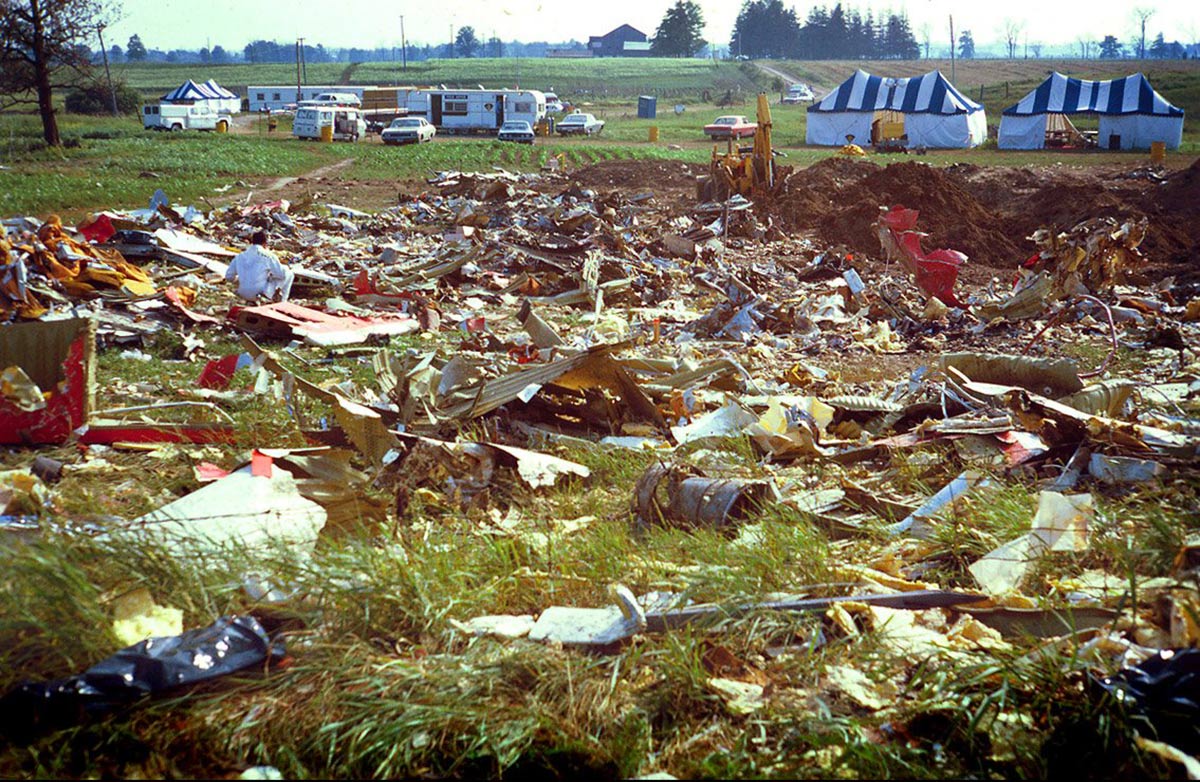
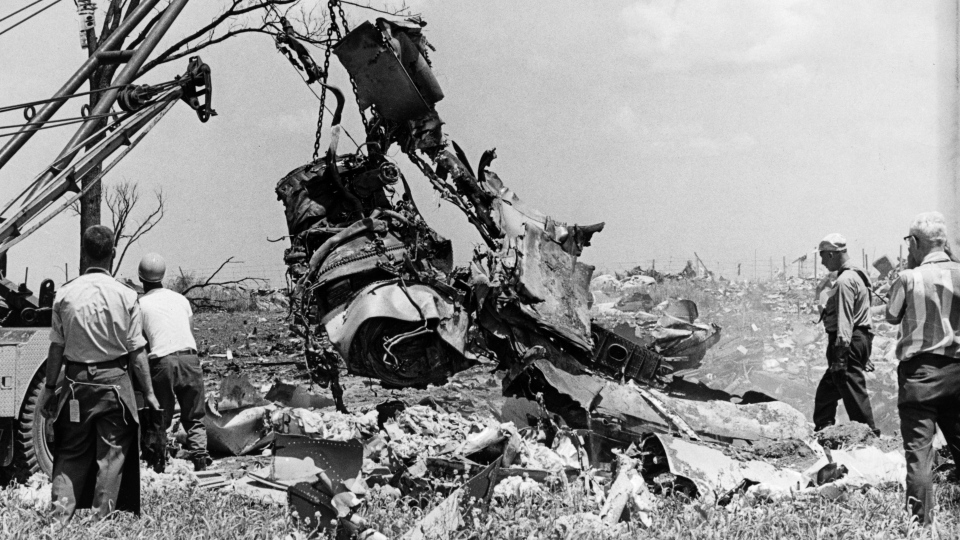
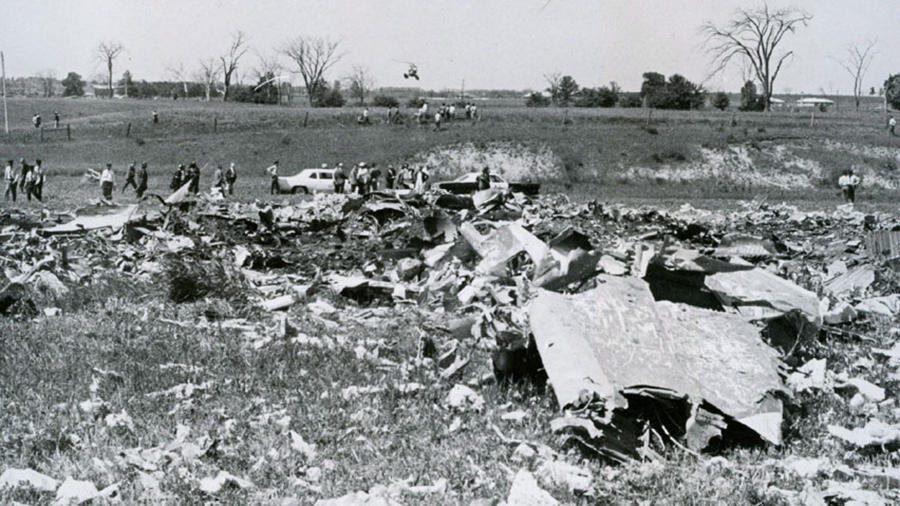

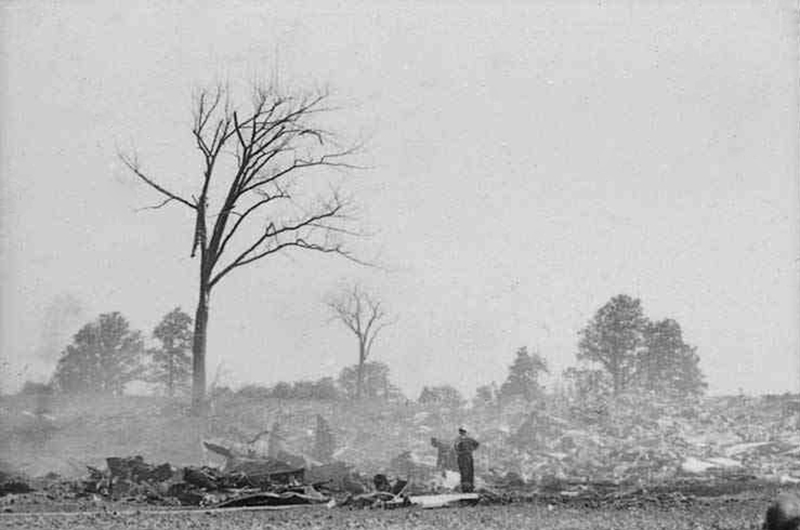
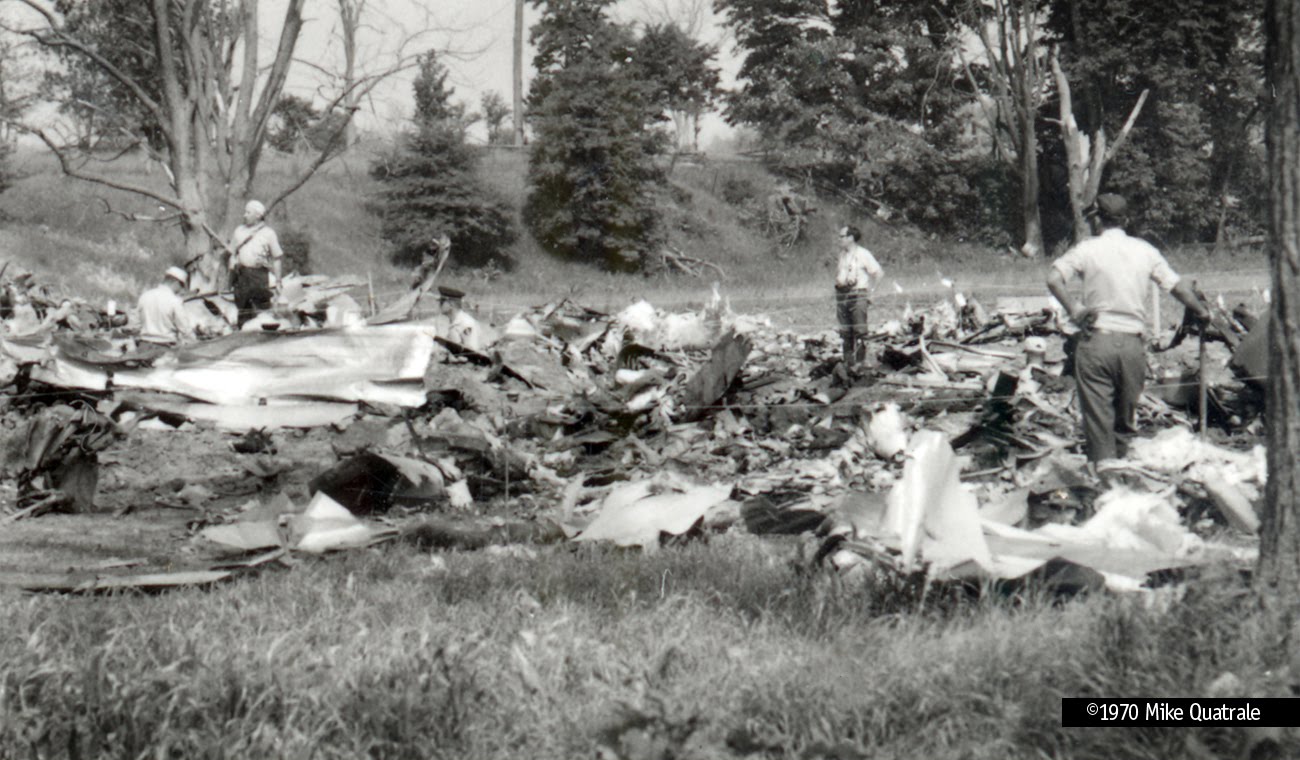
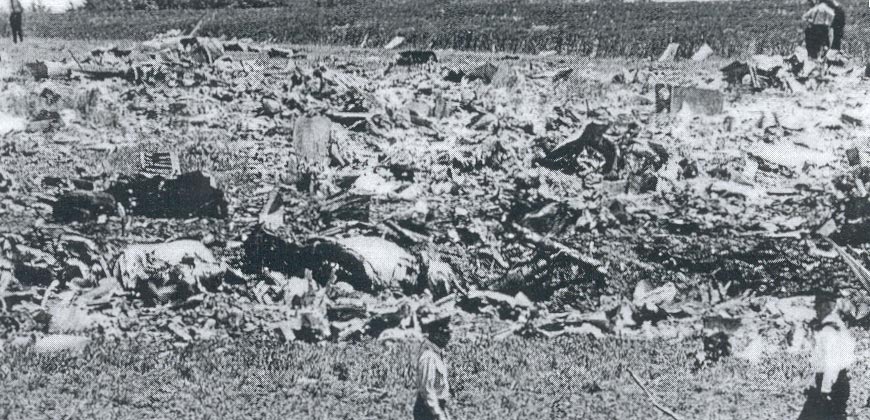
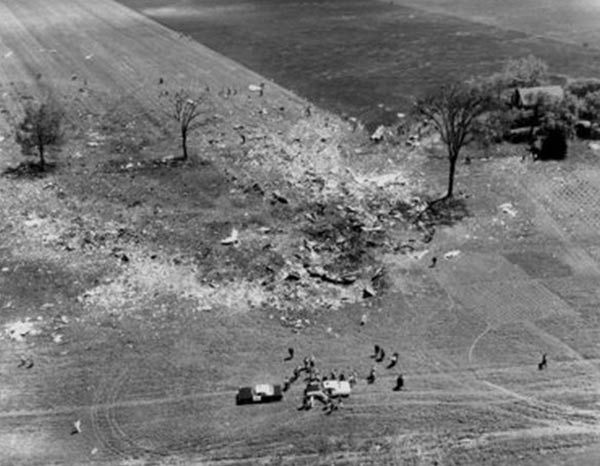

Crash of a Vickers 757 Viscount in Seven Islands: 1 killed
Date & Time:
Apr 7, 1969
Registration:
CF-THK
Survivors:
Yes
Schedule:
Seven Islands - Montreal
MSN:
271
YOM:
1957
Crew on board:
4
Crew fatalities:
Pax on board:
16
Pax fatalities:
Other fatalities:
Total fatalities:
1
Circumstances:
Shortly after takeoff from Seven Islands Airport, while climbing, the crew reported a fire on engine number two and was cleared to return for a safe landing. After touchdown, the crew started an emergency braking procedure when control was lost due to fire in the left main gear wheel well. The airplane veered off runway to the right before coming to rest in flames. A passenger died during the evacuation and the aircraft was written off.
Probable cause:
Overheating of the starter selector relay during starting of no.1 and 2 engines. The proximity of a wire bundle to the relay provided a source of combustibles for the initial fire.
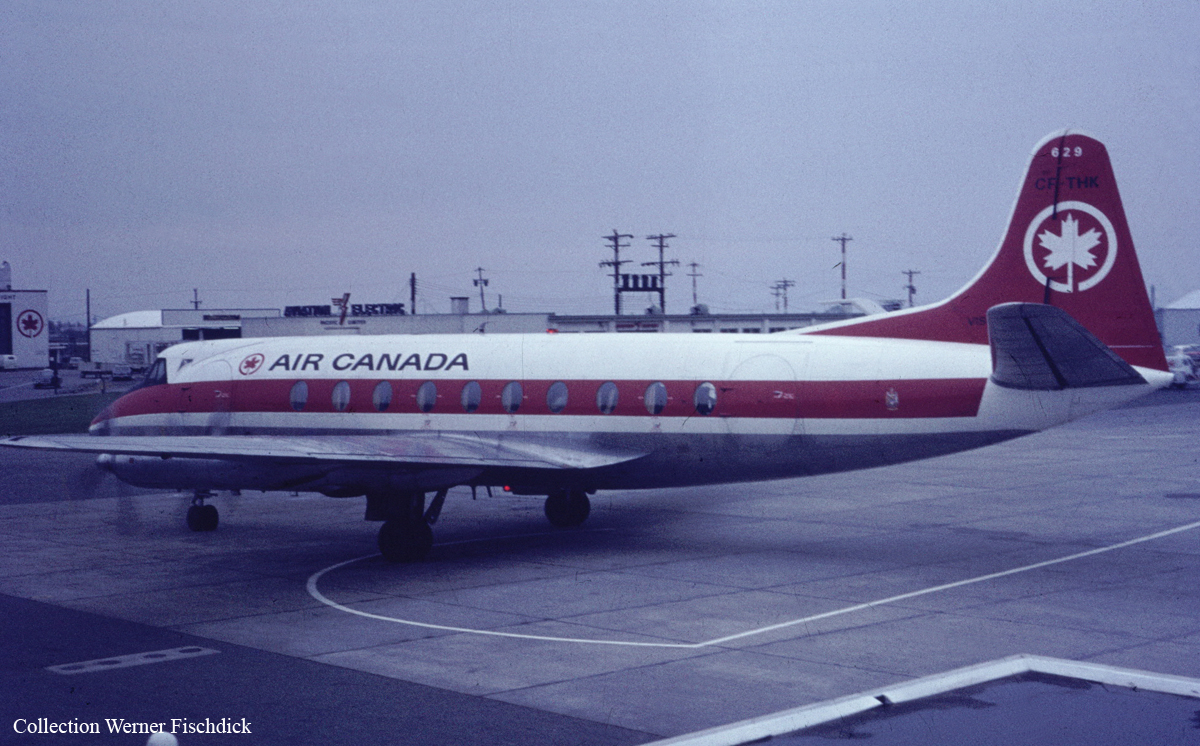
Crash of a Curtiss C-46E-1-CS Commando in Péribonka Lake: 2 killed
Date & Time:
Jun 20, 1966
Registration:
CF-FBJ
Survivors:
No
Schedule:
Montreal - Kuujjuaq
MSN:
2941
YOM:
1945
Crew on board:
2
Crew fatalities:
Pax on board:
0
Pax fatalities:
Other fatalities:
Total fatalities:
2
Circumstances:
After passing over Chute-des-Passes, the crew encountered poor weather conditions when control was lost. The airplane crashed in unknown circumstances in the Péribonka Lake. The wreckage was found three days later. Both pilots were killed.
Probable cause:
The cause of the accident could not be determined.
Crash of a Vickers 757 Viscount in Toronto
Date & Time:
Jun 13, 1964
Registration:
CF-THT
Survivors:
Yes
Schedule:
Montreal – Toronto
MSN:
302
YOM:
1958
Flight number:
AC3277
Crew on board:
3
Crew fatalities:
Pax on board:
41
Pax fatalities:
Other fatalities:
Total fatalities:
0
Captain / Total hours on type:
117.00
Copilot / Total hours on type:
46
Circumstances:
On final approach to Toronto-Lester Bowles Pearson Airport, while at an altitude of 700 feet 3,200 meters from the runway 28 threshold, the engine number lost power. The captain decided to shot down the engine but mistakenly stopped the engine number one. Unable to restart the engine number one, the crew increased power on both right engines number three and four but due to an asymmetric thrust, the airplane banked left then stalled and crashed short of runway threshold. All 44 occupants were evacuated safely while the aircraft was damaged beyond repair.
Probable cause:
The reason of the loss of power on the engine number two was caused by the presence of a foreign object the origine could not be determined. However, the reaction of the crew was incorrect due to lack of coordination.
Final Report:
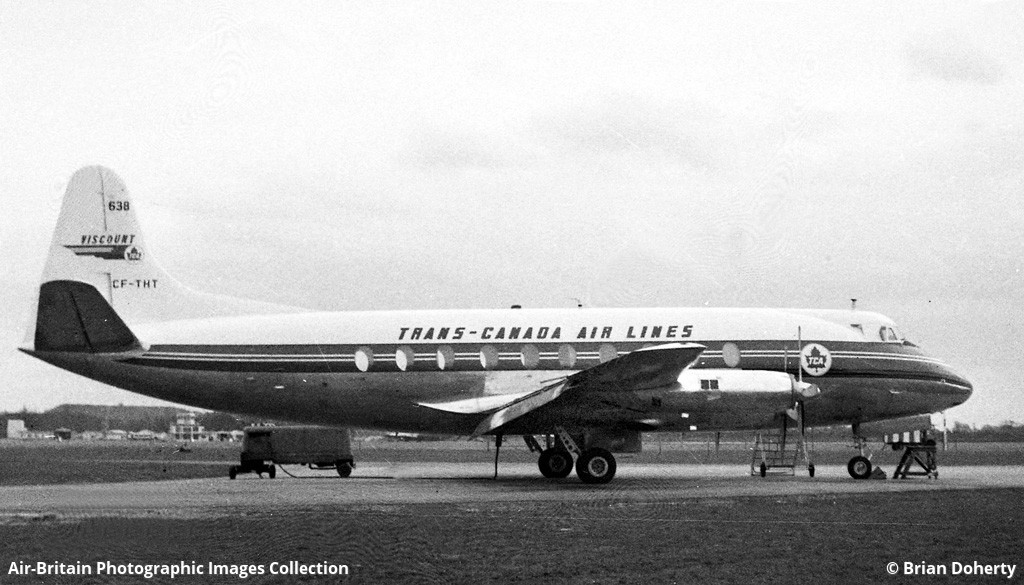
Crash of a De Havilland DH.83C Fox Moth in Longueuil
Date & Time:
Feb 19, 1954
Registration:
CF-BNV
Survivors:
Yes
MSN:
FM.13
YOM:
1946
Crew on board:
1
Crew fatalities:
Pax on board:
1
Pax fatalities:
Other fatalities:
Total fatalities:
0
Circumstances:
While flying at low height, the single engine hit trees and crashed in Longueuil, in the suburb of Montreal. The aircraft was destroyed and both occupants were injured. The airplane was owned by D. Pearson and W. Wilson.
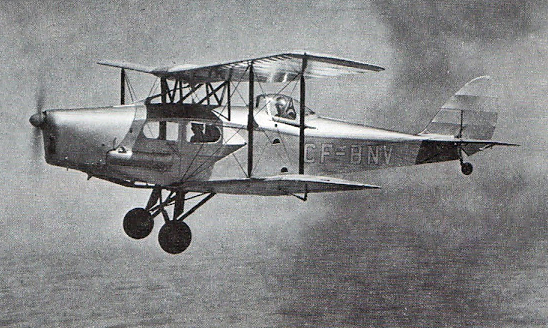
Crash of a Douglas DC-3-178 in Burlington
Date & Time:
Sep 20, 1948 at 1141 LT
Registration:
NC17335
Survivors:
Yes
Schedule:
Montreal – Burlington – New York
MSN:
1921
YOM:
1937
Flight number:
COL003
Crew on board:
3
Crew fatalities:
Pax on board:
14
Pax fatalities:
Other fatalities:
Total fatalities:
0
Captain / Total hours on type:
2537.00
Copilot / Total hours on type:
1517
Aircraft flight hours:
34238
Circumstances:
The flight departed Montreal at 1112LT and was cleared to Burlington by the Civil Aeronautics Air Route Traffic Control to proceed In accordance with visual flight rules. A message was received from the aircraft, by the Colonial radio at Burlington, indicating that it was over the Grand Isle Fan Marker, approximately 25 miles northwest of Burlington at 1135. Colonial radio acknowledged the report and transmitted the latest local weather ceiling 800 feet, visibility 1 mile in heavy rain. This report was acknowledged. Nearing the airport, light rain was encountered. The flight asked Burlington Tower for its existing traffic, and being in the approach control area, farther asked permission to make an approach from its present position. After checking with Boston Air Route Traffic Control establishing that no traffic was in the area, the aircraft was cleared to approach VFR. The windshield wipers were turned on and simultaneously wit passing over the range station at an altitude of approximately 700 feet and sighting the airport, the tower called and stated that it had the ship in sight and that the flight was cleared to land. Flight 3 previously had been informed that the surface wind was west, variable to northwest, 5 mph, and due to a heavy rain occurring east of the airport the pilot elected to use Runway 1. The aircraft headed southwest in order to widen the pattern and establish a downwind leg at a suitable distance from the runway. During the turn to final approach the flaps and landing gear were extended, and descent was made toward the airport aligned with Runway 01. The aircraft landed long and was unable to stop within the remaining runway, overran and came to rest in trees. All 17 occupants escaped slightly injured while the aircraft was damaged beyond repair.
Probable cause:
The Board determines that the probable cause of this accident was the pilot's action in landing too fast and too far down the wet runway following a high approach.
The following factors were considered as contributory:
- The captain elected to land on Runway 1, approximately 3,600 feet in length, the surface wind being west variable, northwest 5 mph,
- Touchdown was at a distance of 1,875 feet from the approach end of the runway, followed by no perceptible deceleration of the aircraft,
- The aircraft again became airborne only 175 feet from the end of the runway, and as a result struck trees adjacent to the airport.
The following factors were considered as contributory:
- The captain elected to land on Runway 1, approximately 3,600 feet in length, the surface wind being west variable, northwest 5 mph,
- Touchdown was at a distance of 1,875 feet from the approach end of the runway, followed by no perceptible deceleration of the aircraft,
- The aircraft again became airborne only 175 feet from the end of the runway, and as a result struck trees adjacent to the airport.
Final Report:







